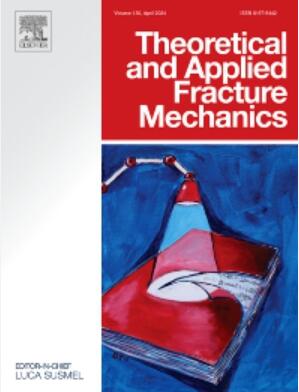An extended coupling method integrating NURBS and meshfree RPIM for accurate 2D crack modeling
IF 5.6
2区 工程技术
Q1 ENGINEERING, MECHANICAL
引用次数: 0
Abstract
Accurately modeling cracks in two-dimensional (2D) solids with complex geometries remains a significant challenge in fracture mechanics. Traditional coupling methods for crack analysis often require complex domain partitioning and boundary condition imposition, limiting computational efficiency. Recently, a novel method known as N-RPIM, which integrates non-uniform rational B-splines (NURBS) and radial point interpolation (RPIM), has demonstrated promise for plane stress simulations in web structures with openings, where the presence of curved boundaries highlights its advantages in geometric representation and numerical accuracy. However, its application to crack analysis remains unexplored, necessitating further development to capture crack behaviors. Building on this framework, this paper develops an extended N-RPIM method (XN-RPIM), incorporating the partition-of-unity technique to accurately model cracks in 2D cases of elastic solids. NURBS basis functions represent domain shapes with precision, while RPIM approximates the displacement field. The Heaviside and branch functions capture surface discontinuities and crack tip singularities, respectively. Unlike existing coupling approaches, the proposed method eliminates the need for subdomain divisions and additional boundary conditions, streamlining the simulation process. Benchmark studies on mixed-mode cracks and intricate configurations demonstrate that XN-RPIM can achieve errors of the stress intensity factor (SIF) below 1% while requiring significantly fewer nodes than the extended finite element method (XFEM) in the best-performing cases. These findings highlight the potential of XN-RPIM as a robust and efficient tool for advanced crack analysis.

一种集成NURBS和无网格RPIM的扩展耦合方法,用于精确的二维裂纹建模
在具有复杂几何形状的二维(2D)固体中精确建模裂纹仍然是断裂力学中的重大挑战。传统的裂纹耦合分析方法往往需要复杂的区域划分和边界条件的设置,限制了计算效率。最近,一种被称为N-RPIM的新方法,将非均匀有理b样条(NURBS)和径向点插值(RPIM)相结合,已经证明了具有开口的腹板结构的平面应力模拟的前景,其中弯曲边界的存在突出了其在几何表示和数值精度方面的优势。然而,它在裂纹分析中的应用仍未探索,需要进一步发展以捕捉裂纹行为。在此框架的基础上,本文发展了一种扩展的N-RPIM方法(XN-RPIM),该方法结合了单元分割技术来精确模拟弹性固体二维情况下的裂纹。NURBS基函数精确地表示区域形状,而RPIM则近似于位移场。Heaviside和branch函数分别捕获表面不连续和裂纹尖端奇点。与现有的耦合方法不同,该方法消除了子域划分和附加边界条件的需要,简化了仿真过程。对混合模式裂纹和复杂结构的基准研究表明,在最佳情况下,XN-RPIM可以实现应力强度因子(SIF)误差小于1%,且所需节点数量明显少于扩展有限元法(XFEM)。这些发现突出了XN-RPIM作为高级裂纹分析的强大而有效的工具的潜力。
本文章由计算机程序翻译,如有差异,请以英文原文为准。
求助全文
约1分钟内获得全文
求助全文
来源期刊

Theoretical and Applied Fracture Mechanics
工程技术-工程:机械
CiteScore
8.40
自引率
18.90%
发文量
435
审稿时长
37 days
期刊介绍:
Theoretical and Applied Fracture Mechanics'' aims & scopes have been re-designed to cover both the theoretical, applied, and numerical aspects associated with those cracking related phenomena taking place, at a micro-, meso-, and macroscopic level, in materials/components/structures of any kind.
The journal aims to cover the cracking/mechanical behaviour of materials/components/structures in those situations involving both time-independent and time-dependent system of external forces/moments (such as, for instance, quasi-static, impulsive, impact, blasting, creep, contact, and fatigue loading). Since, under the above circumstances, the mechanical behaviour of cracked materials/components/structures is also affected by the environmental conditions, the journal would consider also those theoretical/experimental research works investigating the effect of external variables such as, for instance, the effect of corrosive environments as well as of high/low-temperature.
 求助内容:
求助内容: 应助结果提醒方式:
应助结果提醒方式:


